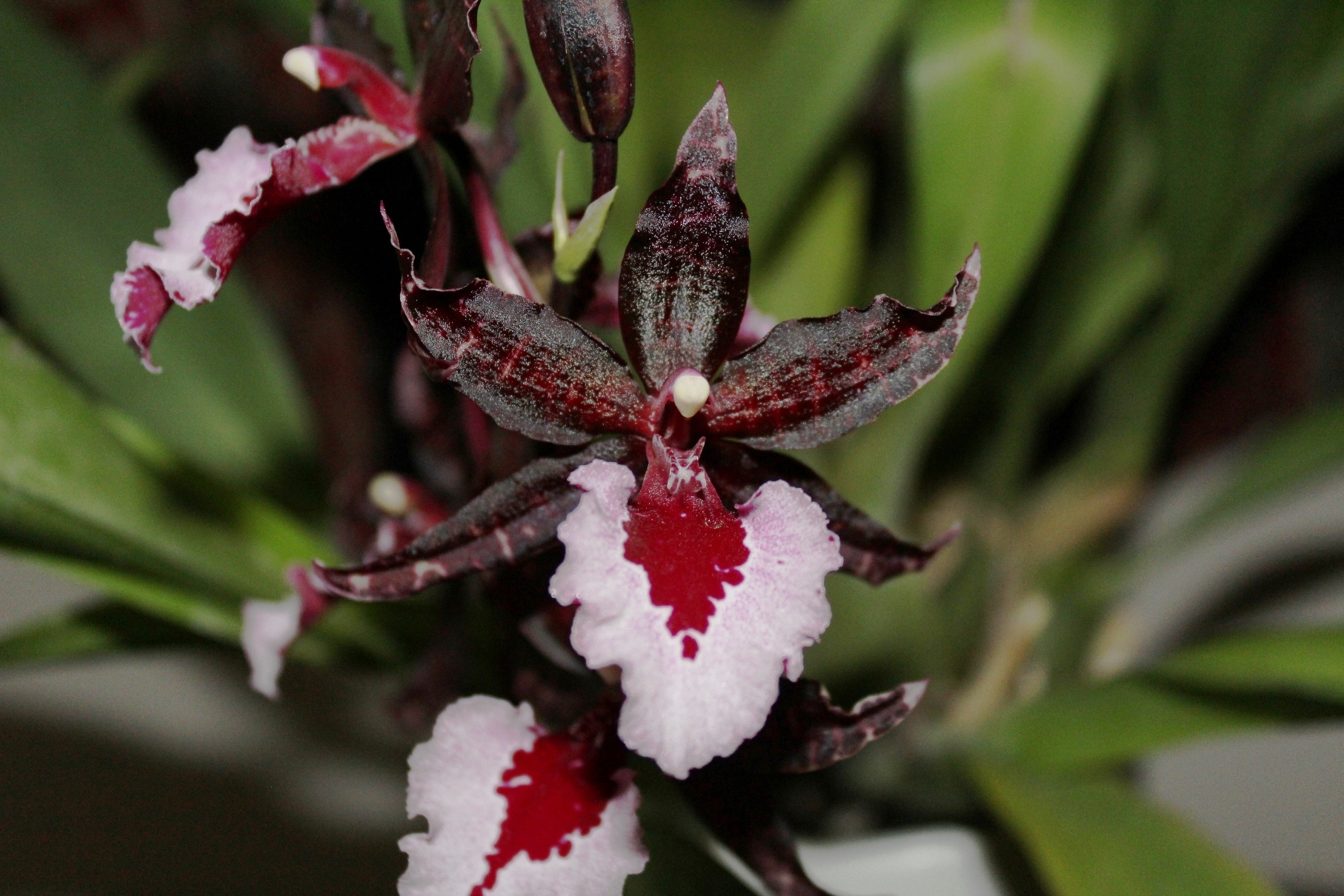
Oncostele Midnight Miracles 'Masai Splash' AGM/RHS, a mass-market cultivar with a perplexing history
March, 2021

RHS Award of Garden Merit for Orchids: Fleeting Fame?
Even at the dawn of orchid mania, when the mere possession of flowering tropical orchids was a mark of high social standing in England, gardening was already commercialized. Even earlier, in the 17th Century, the great Tulip Mania (at its extreme 1636-1637) swept the Netherlands, one of the most famous market bubbles in history, complete with tulip shares on the stock exchange and even a tulip futures market. Market forces, commercial enterprise, and the whims of highly popularized fashion have a very long history of interactions with the appreciation of garden flowers. No one should be surprised to see that the modern commercial orchid industry, based mainly on tissue culture and mass-marketing technologies, is subject to the forces of popular fashion and advertising. Inevitably, popular orchid varieties come and go. The orchid everybody is buying today can disappear almost overnight. However, there is a countervailing force in the orchid world, the Royal Horticultural Society's Orchid Committee, which has attempted to recognize the best orchids in such a way that at least their names will endure, even if the plants themselves may eventually disappear.
While most orchid growers probably see the Royal Horticultural Society (RHS) as a venerable institution whose main interest lies in seeking out and awarding exceptional plants based on their intrinsic, individual qualities, a somewhat academic excercise in applied botany, the RHS has also a long history in advocating for the improvement of "gardens" generally, the "horticulture" component of their mission. The mission of the RHS is now termed a "Vision". The latest iteration seems to be the one from 2015: "To enrich everyone's life through plants, and make the UK a greener and more beautiful place". But wait, there's more! There is also a separate "charitable purpose", more specific and therefore perhaps more useful, "to inspire passion and excellence in the science, art and practice of horticulture".

Award of Garden Merit logo, one of several versions approved by RHS for use by nurseries in marketing awarded plants.
The RHS began the "Award of Garden Merit" program (we will refer to the award as "AGM/RHS", but some parts of the RHS web site show it as "RHS AGM") in 1922, in order to identify outstanding plants that could be recommended "for ordinary garden or greenhouse use". To the extent that the market (i.e., the gardening public and the businesses that cater to them) recognizes the importance of the AGM designation, the existence of this independent certification should help to preserve the best varieties and encourage the development of new varieties with desirable characteristics.
We only learned of the AGM program accidentally, while researching the confusing labels that have been applied to the excellent hybrid illustrated above, now officially known as Oncostele Midnight Miracles 'Masai Splash'. In fact, we discovered the plant itself almost by accident as well, when we needed a sample blooming orchid plant for our information table at the 2018 garden fair at Long Beach City College — we made a quick stop at Lowe's, and there it was, just the right size, something few people would have seen, and only about $14.
The AGM program seems to have been neglected for some time, but in 1992 it was relaunched and thoroughly revised. The program considers trees, vegetables, and decorative plants. In recent years, the awards have been based on specific criteria, including, where possible, field trials. Provisions have been included in the program since 1992 for periodic review, with possible "recission" (withdrawing the award) for reasons such as unavailability to gardeners, better plants becoming available, susceptibility to pests or diseases, or insufficient uniformity. The resulting sporadic purges have made it difficult to follow the history of orchids receiving the AGM. We think it may be possible to reconstruct some of this history through a close reading of Orchid Review.
At various times, the AGM has been awarded to orchids, both those that can be grown in the ground in the UK, and also tropical orchids that must be grown indoors or, as the British like to say, "under glass". But the inclusion of orchids seems to have been a matter of debate or controversy at the RHS, because it is possible to find contradictory statements in odd corners of the current RHS web site. We found award lists dated as late as December, 2020, along with other statements to the effect that all AGM's for orchids had been withdrawn at various earlier dates. The main reason for removing orchids from the AGM lists is that, no matter how good a commercial orchid may look to a judge at a flower show, the recommendation will not be useful to the public unless the plant is readily available. The concerns of the mass-market orchid industry are not usually aligned with the idea of enduring garden merit.
After one of these purges, an interesting list of mass-marketed tropical orchids was issued, with newly-minted AGM awards, in 2012 (Orchid Review, March, 2013, pp. 34-41, the first of a series of articles profiling a total of 35 orchids), along with a helpful account by Liz Johnson, then Vice Chairman of the RHS Orchid Committee and owner of McBean's Orchids, Cooksbridge, East Sussex. After the AGM review process was undertaken in 1992, the changes occurring in the commercial orchid trade, and thus the availability of specific plants to the general public, were gradually understood to be so complex as to make any past selection of AGM orchids nearly useless. The Orchid Committee recommended in 2002 that all orchids other than those suitable for outdoor garden or alpine-house culture should be removed from the list — and we have as yet no idea what those de-listed orchids were! Discussions continued for nearly a decade, until a new plan was germinated. There would be a new, more modern logo, major vendors such as nurseries, garden centers, and supermarkets would be encouraged to use the AGM as a marketing tool — in effect, a certification of quality. The list of AGM orchids would be recompiled based on current conditions, and kept up to date. The criteria for the award were updated as well: Any plant nominated should be Excellent for ordinary use in appropriate conditions, Available, Of good constitution, Essentially stable in form and colour, and Reasonably resistant to pests and diseases. Further, the Orchid Committee has tried to select AGM hybrid orchid candidates from plants already registered, with the possible exception of orchids that already had a consistent trade name, and whose only fault was that they were not yet registered.
Several of the orchids on the list are well known here in Southern California. Dendrobium kingianum has been a staple here for years, easily grown outdoors in areas that don't get too cold. Several cultivars of Oncostele Wildcat regularly show up at orchid club meetings; some have been purchased at local orchid nurseries, others have turned up at home improvement stores, Trader Joe's, etc.
Midnight Miracles, Revealed!
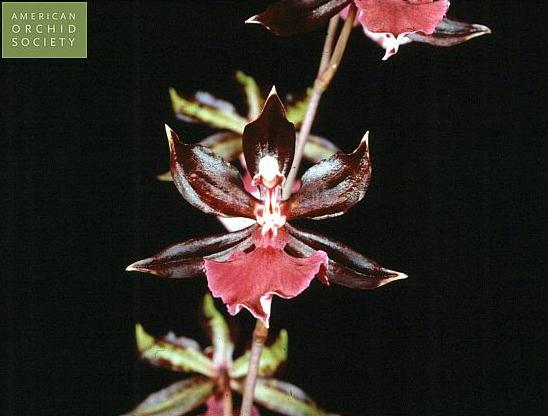
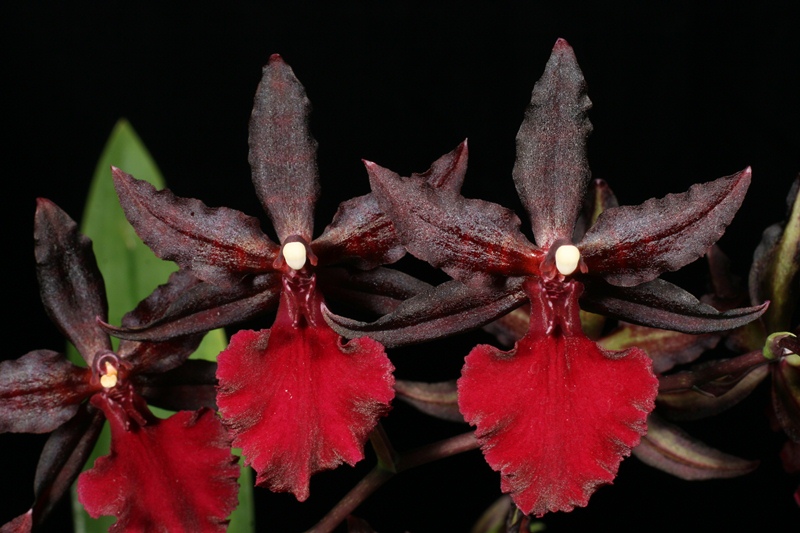
© 1982 AOS and 2013 Larry Livingston
Oncostele Midnight Miracles, the original awarded cultivar 'Red Star' HCC/AOS, exhibited in 1982 at the Los Angeles judging center by Tru-ford Orchids (Fordyce "Red" and Trudy Marsh), and 'Masai Red' HCC/AOS AGM/RHS, now believed to be from the same grex, exhibited in 2013 by Shirlee McDaniels at the Denver Orchid Society Show, Denver, Colorado.
Three more of the AGM orchids merit further discussion. Two that have been marketed under multiple names have eventually been determined to be cultivars of a hybrid originally created by Fordyce "Red" and Trudy Marsh, then called Odontoglossum Midnight Miracles. The parents have since been reclassified as Rhynchostele bictoniensis and Oncidium carniferum, so the hybrid is now Oncostele Midnight Miracles. Somewhere along the line, a Dutch flower company seems to have marketed at least two cultivars with this parentage as Colmanara Masai Red and Colmanara Masai Splash. They were never true Colmanaras, but that name was already familiar in the European commercial orchid trade. Another commercial fad, which continues to this day, was to call any big, showy intergeneric orchid from the Oncidium alliance a "Cambria orchid" (the term is derived from the old hybrid Vuylstekeara Cambria 'Plush'), and eventually, Cambria was used as a genus name: Cambria 'Colmanara Masai Red'! So widespread were these commercial names, that no one seems actually to have known the identity of the plants. The story of how the true parentage was established is found in the registrar's comments in the list of new orchid hybrids for October-December, 2012 (Orchid Review 121, Supplement, p.15):
× Oncostele Midnight Miracles grex, 'Masai Red' — This clone has been distributed for many years under several invalid labels, including × Colmanara Masai ‘Red’, and × Colmanara Masai Red, both of which are regarded as trade designations, and were apparently originated by a Dutch wholesaler as marketing devices. Last year, 2012, Ron McHatton of the AOS, identified these clones as belonging to Midnight Miracles grex (the parentage now classified as Rhynchostele bictoniensis × Oncidium cariniferum). Now that this and the following clone have been identified, the trade designations are here adopted and established as cultivar epithets, in the absence of any known valid cultivar names, pursuant to an RHS Award of Garden Merit. ‘Masai Red’ is illustrated and commented on by the late Joyce Stewart in The Orchid Review 115(1278): 349 (Nov 2007). Description: Inflorescence erect, bearing about 13 well-spaced alternate, flowers. Sepals and petals similar, lanceolate, brownish maroon, with slightly undulate margins. Lip deep red, semi-circular, pleated, narrowed abruptly into a red callus-bearing isthmus. Anther cap white.
× Oncostele Midnight Miracles grex, ‘Masai Splash’ — See above for details. Description: Similar to ‘Masai Red’, but differing in the coloration of the flower. Sepals and petals dark red, somewhat speckled. Lip white at the margin becoming darker maroon red towards isthmus, with a reticulate dark red veined pattern in between.
We kept digging. In OrchidWiz (the computer program described as the "orchid encyclopedia", see orchidwiz.com), we spotted an entry for Colmanara MASAI RED, originated and registered, according to this source, in 2007, by Anthura B.V., in Bleiswijk, The Netherlands. Some internet sources specify that it was registered in July, or even exactly on July 9, 2007, but listing its parents as "unknown". On a French internet orchid bulletin board, we learned that these plants were offered for sale in Europe as early as 2009, and at that time, there was still an entry in the RHS International Orchid Register displaying the registration information. However, we were unable to find this registration in the RHS quarterly lists in 2006-2008. The registration was probably withdrawn before the quarterly lists were published, but remained in the database for some time. But perhaps this old but now unfindable registration tells us where and when the confusion arose.
Looking more closely at the awards photos for Midnight Miracles, especially for plants awarded by AOS, we noticed an interesting detail. The awards from 1982 to 2001 show a rounded, more or less spade-shaped lip, while later awards (2013 to 2019, so far) show a pointed lip. The details of the callus at the base of the lip differ as well. However, the shape of the lip in Rhynchostele bictoniensis itself varies from rounded to pointed, and the lip color varies from white to deep pink. We think the newer plants, the ones with Masai in the name, probably represent a re-make of the original Midnight Miracles cross, using a bictoniensis with a larger, pointed lip. Whether all the different colors of the commercial 'Masai' cultivars came from the same pod is not known, but the flowers appear to be virtually identical apart from the colors. Anthura, by the way, seems to have moved on, they are now marketing several new but unregistered "Cambria" orchids with names like BAROCO and RENAISSANCE.
We are delighted to see that "Red" and Trudy Marsh, in their time steadfast friends of SCOS and all things orchid in Southern California, are now credited with this striking grex, which seems to adapt well to outdoor culture in our area.
Oncidesa Sweet Sugar and the "Trader Joe's" Oncidium:
More than One "Dancing Lady" Orchid in the Grocery Store!
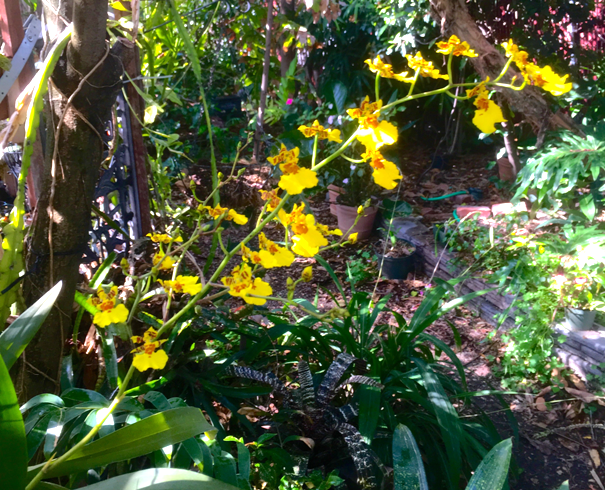
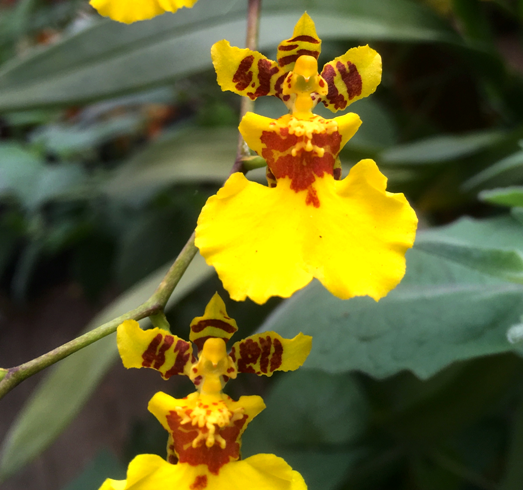
The "Trader Joe's Oncidium", growing outdoors in Long Beach, California, and divided several times, since the mid 1990's.
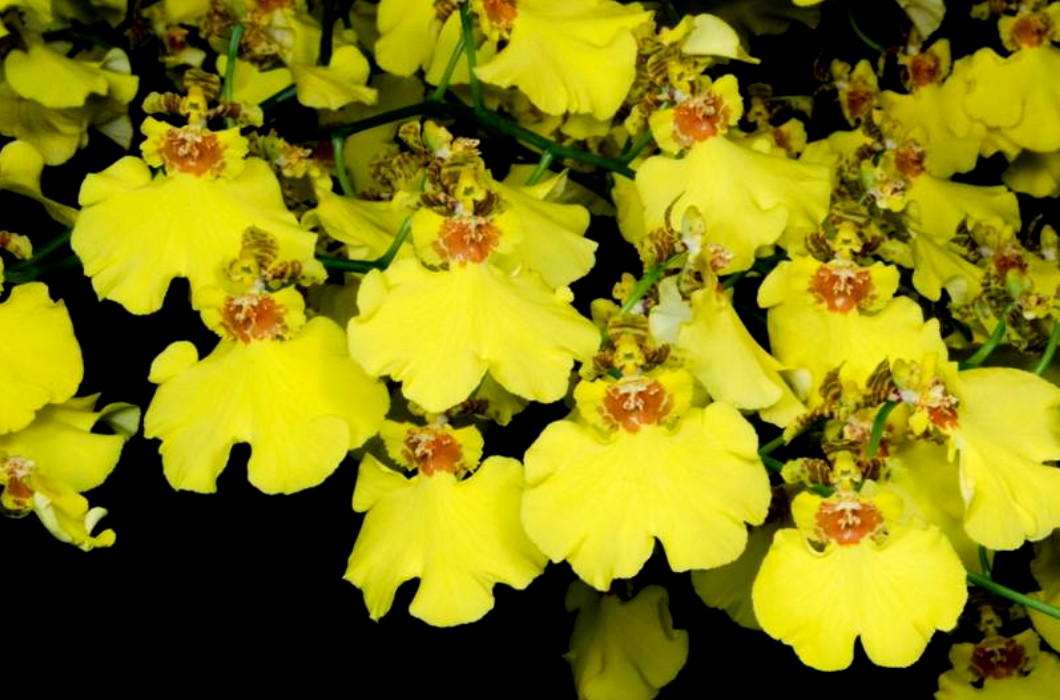
© 2017 Arnold Gum
Oncidesa Sweet Sugar 'Memoria Richard Waugh' AM/AOS, exhibited by Deborah Halliday at the San Diego judging center
There are several Oncidium hybrids in the mass-market orchid trade that produce big sprays of bright yellow "dancing lady" or "golden shower" flowers. One of them made the AGM list, Oncidesa Sweet Sugar. This is a good choice for the AGM award. Liz Johnson calls it "one of the most cloned orchids in the world, and sold by the thousand both as cut flowers and as plants". It originated at the Sato nursery in Hawaii in 1990, and it appears this orchid was still widely available in the UK in large supermarkets and DIY stores, and in fact throughout the world, when the AGM list was published in 2013. Significantly (see below), we found it still offered for sale by EcuaGenera.
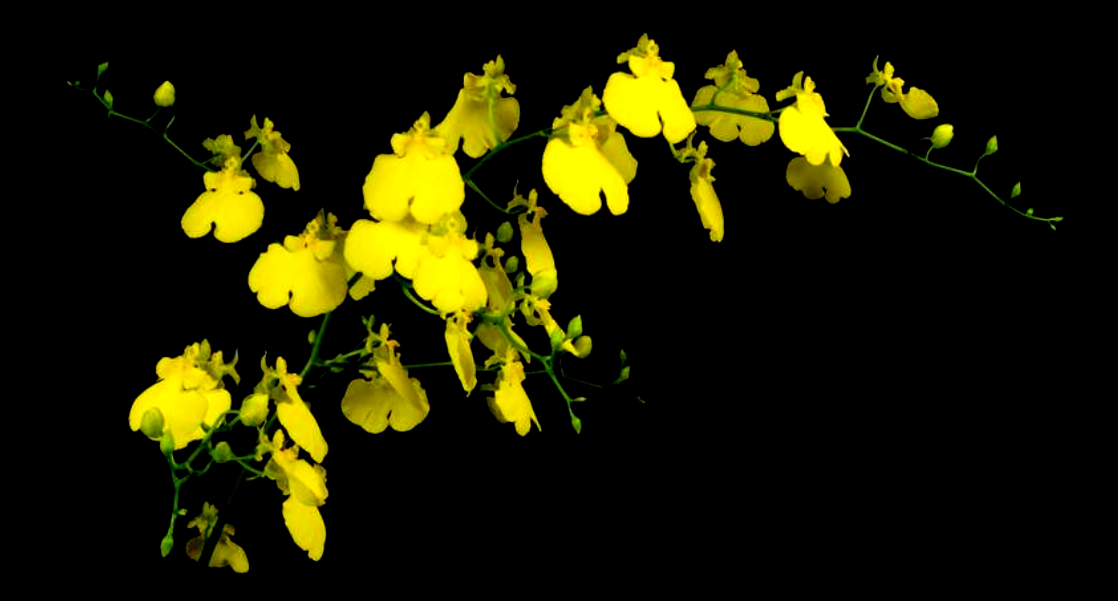
© 2015 Glen Barfield
Oncidesa Sweet Sugar 'Lemon Drop' HCC/AOS, exhibited by Hilo Orchid Farm at the Hilo Orchid Show
We have exchanged messages with several experienced growers in our area who bought a similar "golden shower" orchid from Trader Joe's, with no label, in the 1990's. Could it be Sweet Sugar? It was initially hard to reconcile the details of the "Trader Joe's Oncidium" flowers with those we saw on labeled plants at shows. Now we realize that there have been several named cultivars of Sweet Sugar in circulation. One of them, 'Lemon Drop', is almost pure yellow, with a strongly notched lip. The other cultivars seen in AOS awards photos have varying amounts of brown striping on the tepals and red-brown marks at the base of the lip, which in some of them is less strongly notched. We suppose that this hybrid has been mericloned repeatedly, starting perhaps from different seedling plants, and as a result, that variations in the details of the flowers have crept in through succeeding production cycles. Still, we were bothered by some differences between our "Trader Joe's" plant and the awarded Sweet Sugar cultivars. Eventually, it became clear that there are at least two other widely distributed "golden shower" orchids. We think we have found the answer, see below.
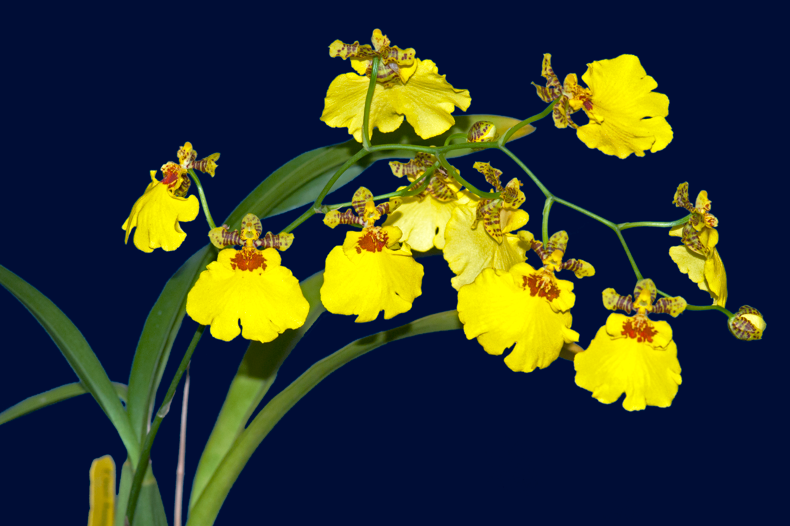
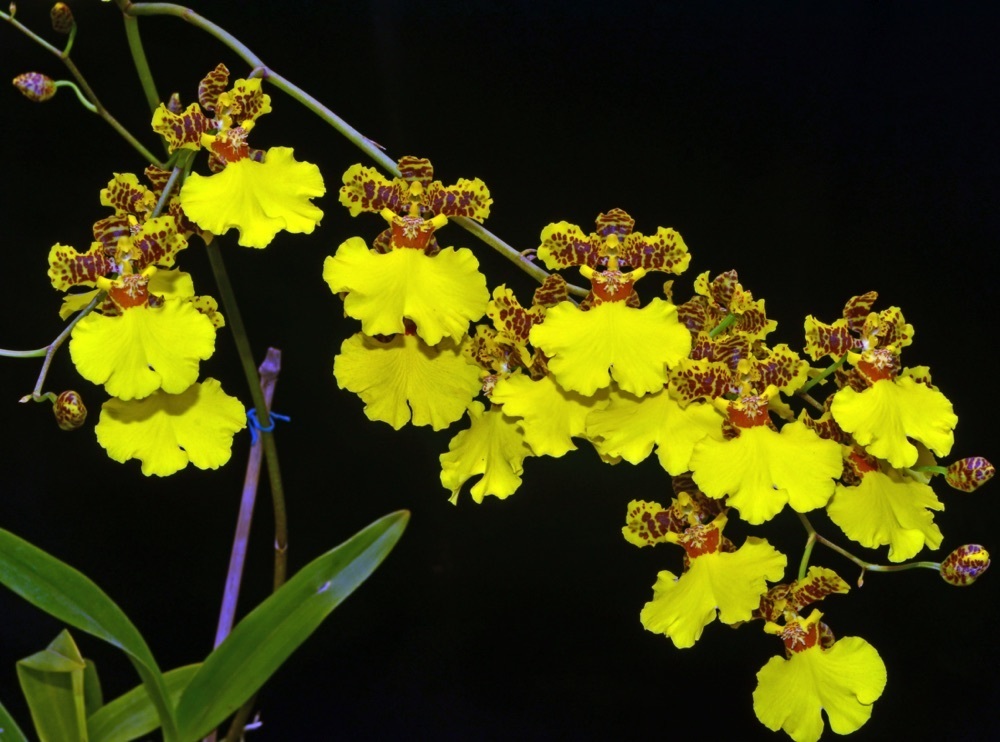
Oncidium Sweet Sugar (unnamed cultivar) and Oncidium Sweet Sugar 'Golden Shower', illustrations from the EcuaGenera web site, where both varieties are offered for sale.
One of the cultivars of Sweet Sugar is marketed as 'Golden Shower'. EcuaGenera now carries this cultivar, as well as second one that lacks a cultivar name. The photograph of this unnamed cultivar in their on-line catalogue is perhaps the best match within the Sweet Sugar grex that we have found for our Trader Joe's plant. This form does not seem to have won any awards. Probably the best and most recent award for Sweet Sugar is the cultivar 'Million Dollars' AM/AOS, definitely worth finding!
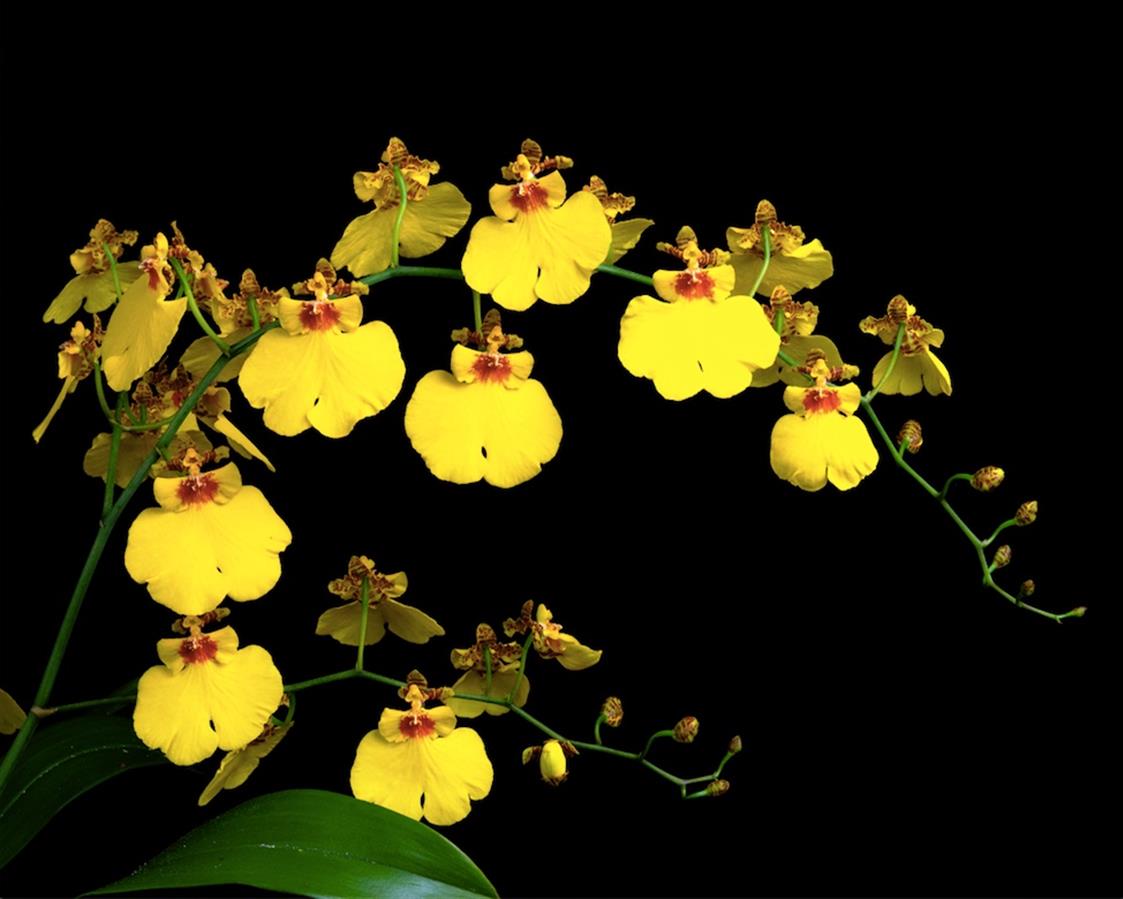
© 2019 Brian Monk
Oncidesa Sweet Sugar 'Million Dollars' AM/AOS, exhibited by Kathryn Romine at the Naples Orchid Show, Naples Botanic Garden, Naples, Florida
Have We Finally Identified the "Trader Joe's Oncidium"?
In addition to Sweet Sugar, two other Oncidesa hybrids are widely available and functionally similar: Goldiana and Gower Ramsey. All three of these hybrids have similar ancestry. There are a number of other possibilities, but as far as we know they are not widely distributed and many are too recent to have been in the mass market in the mid 1990's. There are some differences in the proportions, colors, and markings. Sweet Sugar has the largest lip. Goldiana has the most prominent callus at the base of the lip. There are clear differences in the color and markings on the tepals, note especially the degree of contrast with the coloring in the middle of the lip. One feature that makes us think Gower Ramsey is the correct solution is that the markings on the tepals are bold and distinct, rather than finer in Sweet Sugar, and less distinct in Goldiana. Here they are for comparison. Are you convinced?
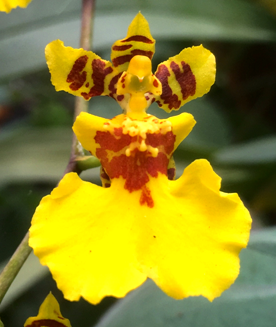
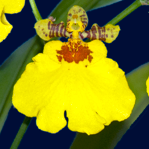
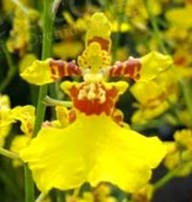
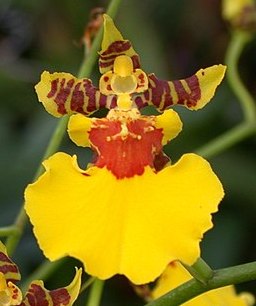
"Trader Joe's Oncidium" and three similar Oncidesa hybrids (presumably identified correctly) with their dates of registration: Sweet Sugar (1990), Goldiana (1940), and Gower Ramsey (1977).
Even More AGM Orchids
The choice of orchids for the 2012 AGM list seems strange, in light of the variety of "grocery store" orchids we see here in Southern California. In almost every case, we could easily find better alternatives during our routine shopping. Clearly, the "grocery store orchids" found in the UK are frequently different from those in our local Trader Joe's or Home Depot. There is every reason to expect that some of our local mass market orchids are every bit as worthy of recognition!
The awards list of 2012 is also a bit short of Phalaenopsis (there were only three, not very interesting), currently the most popular orchid for home use in the world. We spotted a couple reasons for this apparent omission. First, the articles by Liz Johnson mentioned in passing the wish by the Orchid Committee that the public should be encouraged to expand their orchid experience by trying something new! The diversity of the list was a conscious step in that direction. Second, most of the "grocery store" Phalaenopsis orchids they encountered during their discussions were entirely unlabeled, and even the few that had labels would disappear from one month to the next, so there was no realistic way to recommend a particular variety, even if it was exceptionally desirable for its performance as a house plant.
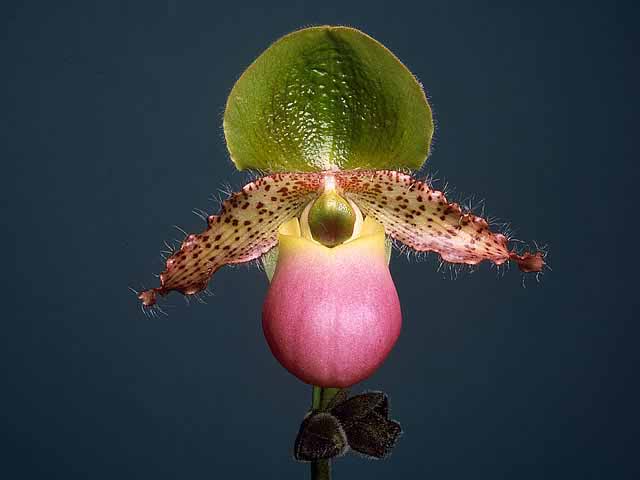
© 2003 Greg Allikas
Paphiopedilum Pinocchio 'Star' AM/AOS, exhibited in 2003 by June Hill at the Miami International Orchid Show, Miami, Florida
Roughly the opposite question occurred to us when we looked at the 2012 AGM selections for Paphiopedilum. Why were the hybrids Claire de Lune, Leeanum, and Pinocchio chosen, out of hundreds or even thousands of possibilities? How could any single Paph, whether species or hybrid, possibly meet the availability criterion, given that Paphs still can't be reliably cloned in large enough numbers to support a commercial trade? For the primary hybrid Pinocchio (glaucophyllum × primulinum), we think we know the answer. The cross of the two parental species apparently produces enough viable seed, and the seeds are easy enough to grow, that they yield a uniform seedling crop, sufficient for the development of a mass market. The originator of this hybrid (1992) was Marcel Lecoufle, of the venerable firm of Vacherot et Lecoufle, which has supplied Pinocchio for the European market. In the US, Carter and Holmes noted on their web site that Pinocchio is one of their best sellers. Seedling flasks of this hybrid can be found on the internet. Here in Southern California, small and apparently well-adapted Paphs have shown up occasionally at Lowe's. We came very close to including a few among the SCOS raffle plants in 2019, before someone supplied a better assortment of plants at the last minute. Does anybody have one?
By 2020, however, the list of AGM Phalaenopsis plants had grown to include one species Phal. amabilis, ten registered hybrids, and nine commercial cultivars without a grex name, for a total of 20. The complete 2020 AGM orchid list also includes a dozen varieties from the Oncidium alliance, perhaps, overall, a reasonable reflection of the current state of the "grocery store" orchid trade. The 2020 list is rounded out with a smattering of oddities and perhaps more aspirational orchids, for a total of 52.
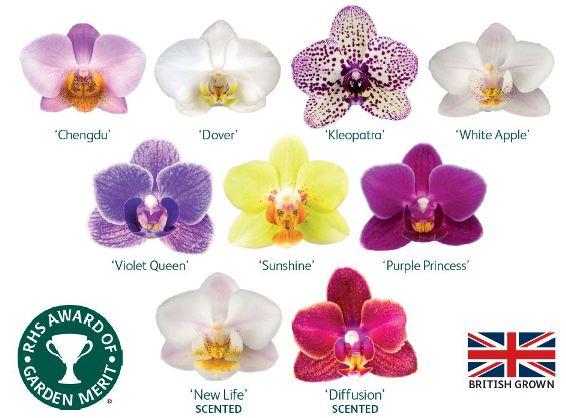
AGM Phals marketed by Love Orchids, the retail orchid web site of Double H Nurseries, UK. These are all trade names or cultivar names, not registered hybrid names. Have you ever seen any of these in the US?
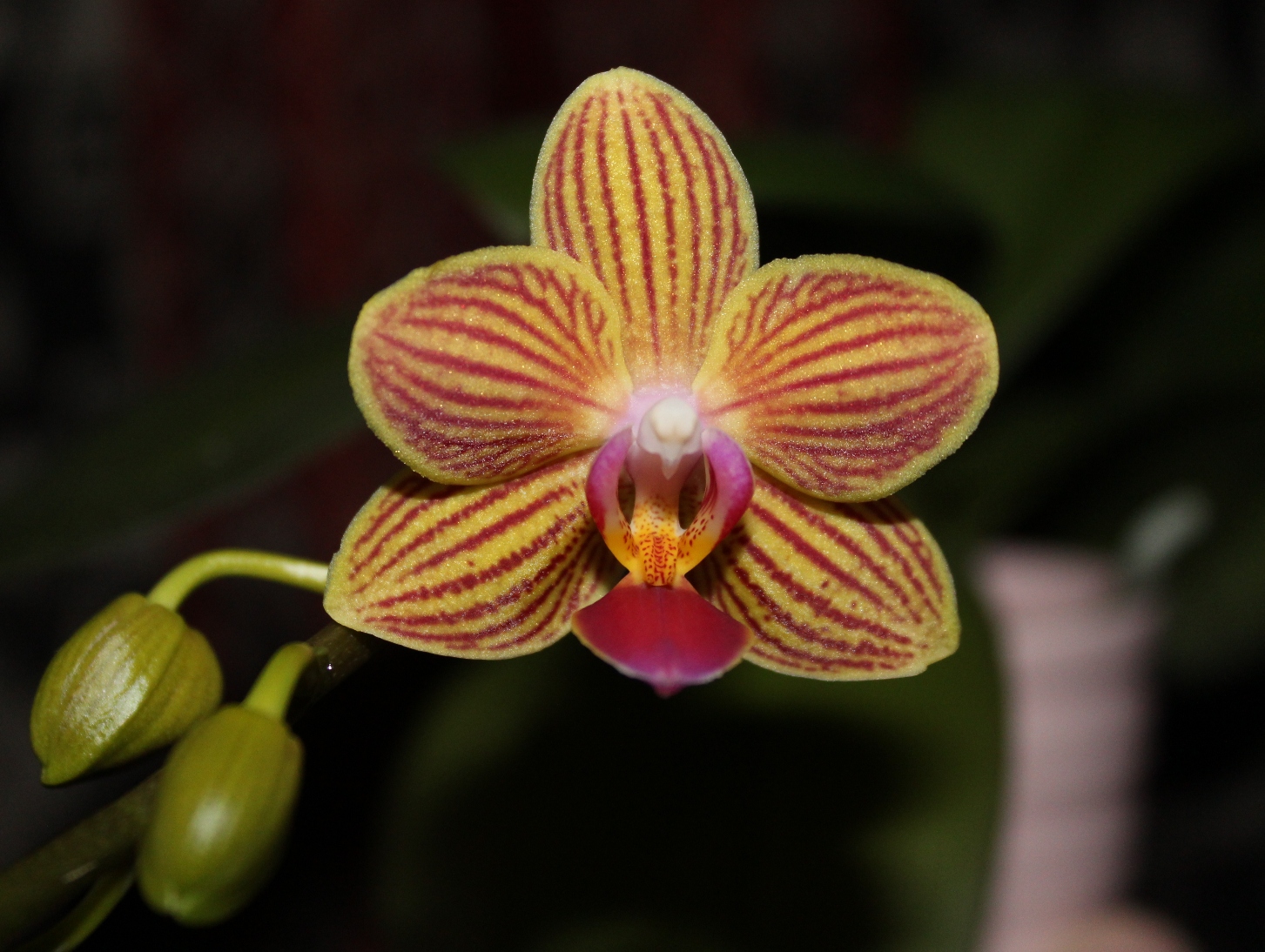
Phal. Chingruey's Goldstaff AGM/RHS. This commercial cultivar (we found this one as a half-price plant at Lowe's) is likely the one called 'C', TRO/TOGA, exhibited by OX Orchids Farm, Tainan County, Taiwan, in 2011; other cultivars are mostly rosy purple.
We found one of the registered AGM Phals at Lowe's a couple years ago, Phal. Chengruey's Goldstaff. The others don't seem to be in the local trade at all. But we found essentially all of the "trade name" orchids on the Love Orchids web site, the on-line retail orchid marketing arm of Double H Nurseries in the UK. There was only one exception, 'Picaso' (the only "harlequin"-type Phal on the AGM list) had been replaced by 'Purple Passion' (not a "harlequin"). Which came first, the AGM awards to these nine "trade name" orchids, or their cultivation by Double H Nurseries? We haven't been able to find out. They form a very interesting assortment that many hobbyists will enjoy.
Overall, the AGM orchids for 2020 seem well-suited for the amateur grower, but they are hardly the last word in adaptable, floriferous orchids. The commercial orchid industry from which they are sourced changes rapidly, emphasizing the next new, "must-have" flower. It is unlikely that many of the AGM orchids will pass the avability test for more than a couple years, and so the awards will always be chasing newer varieties. These don't seem to be the sort of awards that will last, even if they can help the beginning orchid fancier gain experience and knowledge.
The Award of Garden Merit as a part of the business strategy of RHS
The RHS web site seems to have something for everyone. That is by design; the RHS "Vision" explicitly includes "everyone". For orchid lovers, the RHS web site includes the searchable orchid hybrid registration database, the published quarterly lists of new orchid hybrid registrations, newsletters from various orchid-related boards and committees, lists of intergeneric orchid names and abbreviations, and now, even virtual plant shop, featuring a selection of 22 types of orchids, available for shipping within most of the UK, although Brexit seems to had placed some areas off limits. One of these orchids bears the AGM logo, Cymbidium Sarah Jean 'Ice Cascade'. We spotted a notice on the shopping portal that says "Every purchase supports the work of the RHS", but we did not find any further details. Among the other, non-orchid plants available through the shopping portal, we spotted any number of ordinary outdoor Southern California garden plants marketed by RHS as house plants or office plants, including a typical but AGM-awarded Sansevieria for £19.99.
Exactly how RHS profits from the AGM awards is not entirely clear to us, but businesses are invited to inquire about the purchase of license agreements for "annual multiple use of RHS Award of Garden Merit point-of-sale artwork".